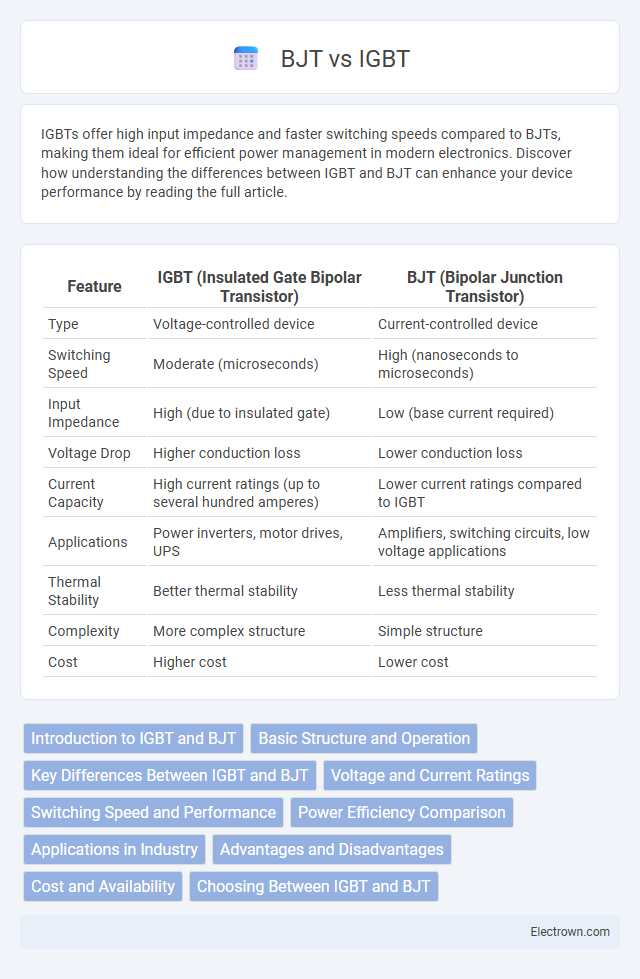IGBTs offer high input impedance and faster switching speeds compared to BJTs, making them ideal for efficient power management in modern electronics. Discover how understanding the differences between IGBT and BJT can enhance your device performance by reading the full article.
Table of Comparison
| Feature | IGBT (Insulated Gate Bipolar Transistor) | BJT (Bipolar Junction Transistor) |
|---|---|---|
| Type | Voltage-controlled device | Current-controlled device |
| Switching Speed | Moderate (microseconds) | High (nanoseconds to microseconds) |
| Input Impedance | High (due to insulated gate) | Low (base current required) |
| Voltage Drop | Higher conduction loss | Lower conduction loss |
| Current Capacity | High current ratings (up to several hundred amperes) | Lower current ratings compared to IGBT |
| Applications | Power inverters, motor drives, UPS | Amplifiers, switching circuits, low voltage applications |
| Thermal Stability | Better thermal stability | Less thermal stability |
| Complexity | More complex structure | Simple structure |
| Cost | Higher cost | Lower cost |
Introduction to IGBT and BJT
Insulated Gate Bipolar Transistor (IGBT) combines the high input impedance of a MOSFET with the low saturation voltage of a Bipolar Junction Transistor (BJT), making it ideal for high-power applications. BJT is a current-controlled device used primarily for amplification and switching with faster switching speeds but higher conduction losses compared to IGBTs. Both semiconductor devices play crucial roles in power electronics, with IGBTs preferred for medium to high voltage operations and BJTs favored for low voltage, high-frequency switching.
Basic Structure and Operation
IGBT (Insulated Gate Bipolar Transistor) combines the high input impedance of a MOSFET with the low conduction losses of a BJT, featuring a gate, collector, and emitter in its structure. BJT (Bipolar Junction Transistor) operates through current-controlled charge carriers with distinct emitter, base, and collector regions, relying on minority carrier injection for amplification. Your choice between IGBT and BJT depends on the required switching speed and efficiency, as IGBTs offer fast switching with high voltage capability, while BJTs provide robust current handling and linear amplification.
Key Differences Between IGBT and BJT
IGBT (Insulated Gate Bipolar Transistor) combines the high input impedance of a MOSFET with the low on-state power loss of a BJT (Bipolar Junction Transistor), making it suitable for high-voltage and high-current applications. BJT operates with a current-controlled mechanism, whereas IGBT is voltage-controlled, resulting in simpler driving circuits for IGBT. IGBTs offer faster switching speeds, higher efficiency, and better thermal performance compared to BJTs, which are preferred in low-voltage, high-frequency environments.
Voltage and Current Ratings
Insulated Gate Bipolar Transistors (IGBTs) typically offer higher voltage ratings, often exceeding 600V and reaching up to several kilovolts, making them suitable for high-voltage applications. Bipolar Junction Transistors (BJTs) generally have lower maximum voltage ratings, usually below 1000V, but they can handle significant current with good linearity. The current handling capability of IGBTs is optimized for medium to high power levels, combining the high input impedance of MOSFETs with the low saturation voltage of BJTs, while BJTs excel in low to medium power scenarios with faster switching speeds but higher driving current requirements.
Switching Speed and Performance
IGBTs (Insulated Gate Bipolar Transistors) offer faster switching speeds compared to BJTs (Bipolar Junction Transistors) due to their MOSFET-like gate structure, which reduces input current and switching losses. Your choice of IGBT enhances performance in high-frequency applications and power electronics by enabling efficient handling of large voltages and currents with minimal thermal dissipation. While BJTs provide linear amplification advantages, they typically exhibit slower switching speeds and higher power losses than IGBTs in dynamic operation.
Power Efficiency Comparison
IGBTs offer higher power efficiency than BJTs due to their lower conduction losses and faster switching capabilities, making them ideal for high-voltage, high-current applications. Your power systems benefit from IGBT's ability to reduce energy dissipation and heat generation, which enhances overall system performance and reliability. BJTs, while simpler and cost-effective for low-voltage tasks, generally exhibit higher power losses and slower switching speeds compared to IGBTs.
Applications in Industry
IGBTs are extensively used in industrial applications requiring high efficiency and fast switching, such as motor drives, electric vehicles, and power inverters, due to their ability to handle high voltage and current with low power loss. BJTs find application in low-power amplifiers and switching circuits where precise control and linearity are essential, especially in analog signal processing and audio equipment. Your choice between IGBT and BJT depends on factors like switching speed, voltage rating, and thermal performance specific to the industrial application.
Advantages and Disadvantages
IGBTs offer higher efficiency and faster switching speeds compared to BJTs, making them ideal for high-power applications such as motor drives and inverters. BJTs provide better linear amplification and are more rugged in terms of overcurrent tolerance but suffer from higher power losses and slower switching. The trade-offs include IGBTs' higher conduction voltage drop versus BJTs' lower gain at high frequencies, influencing their selection based on switching speed, thermal performance, and application requirements.
Cost and Availability
IGBTs generally have a higher initial cost due to their advanced semiconductor structure but are widely available in various power ratings, making them cost-effective for high-voltage applications. BJTs are typically less expensive upfront and easier to source for low-power, low-frequency uses, though their performance limitations can lead to higher operational expenses. Market availability favors IGBTs for industrial and renewable energy sectors, while BJTs remain common in legacy and basic electronic circuits.
Choosing Between IGBT and BJT
Choosing between IGBT and BJT depends on switching speed, voltage, and current requirements. IGBTs excel in high-voltage, high-current applications with better efficiency and lower switching losses, making them ideal for inverters and motor drives. BJTs offer faster switching speeds and simpler driving circuits, suitable for low-voltage, low-power applications where linearity and amplification are critical.
IGBT vs BJT Infographic

 electrown.com
electrown.com